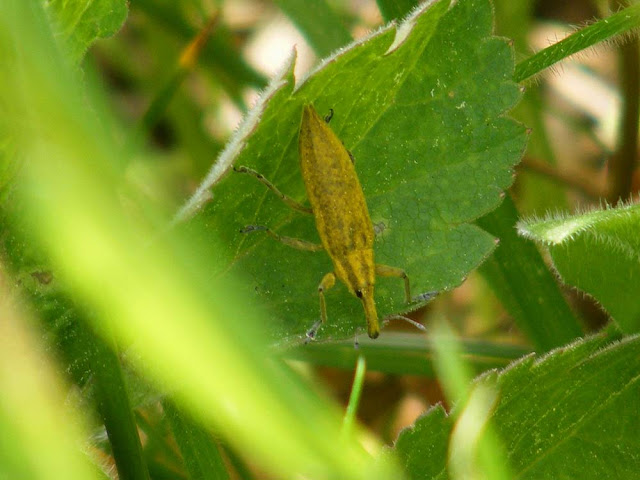This blog post isn't nearly as sinister as the title makes it sound. The weevil in question is Lixus iridis. The warning is that if I had relied solely on Michael Chinnery's excellent field guide to the Insects of Britain and Western Europe, as many people with an interest in insects do, I would have misidentified this beetle as L. paraplecticus.
Chinnery, with its wonderful illustrations and scope across many different orders of insect is great for quickly getting you close to an identification. It is deservedly the most widely owned and used field guide for insects in both Britain and France (it has been translated into French).
However, using it comes with a 'health' warning. Chinnery does not always choose the most likely species nor does he always say if there are any lookalikes. It pays, always, to check online if there are alternatives that are a better fit with the insect you've found.
The illustration of L. paraplecticus in Chinnery is a close match for my weevil -- a strange elongated creature shaped like a torpedo and completely covered in gold fuzz. Chinnery's commentary fits perfectly -- 'Elytra dark, covered in yellow scales. On stems of various umbellifers in damp places in autumn and spring'. Mine was sitting on a Wild Parsnip Pastinaca sativa in our orchard the other day.
But with years of using Chinnery behind me I knew that I couldn't assume I'd found my beast. I did a general check on the internet for L. paraplecticus which turned up quite a few weevils in this genus. Chinnery states that L. paraplecticus may be extinct in Britain. This turns out not to be the case, but there isn't much in English on the weevil as it is clearly rare in Britain.
So then I checked Le Monde des Insectes to see what this excellent French website, forum and gallery had to say. They had good photos of Lixus paraplecticus and several other Lixus spp and best of all, a key for the genus. For many groups, Le Monde des Insectes is the most accessible source of comprehensive and definitely the most trustworthy and accurate source of information. They work closely with the Office pour les Insectes et leur Environnement (OPIE), being the citizen science arm of this quango attached to the Institut National de la Recherche Agronomique (INRA).
The key reveals that whilst my weevil has long pointy elytra tips, they are not long enough or spreading enough to be L. paraplecticus. Working through the key gets me to L. (Eulixus) iridis.
L. iridis is quite a large weevil, but with a weevil's distinctive long snout. It is covered in greeny yellow pubescence, which gets worn off as the beetle ages, so older specimens are the black of the underlying chitin. The species is widespread in central France.
In English Lixus spp weevils are known as yellow weevils. In French L. iridis is called le Lixus des iris. The word for weevil in French is charançon.




3 comments:
What a strange creature. Interesting how a section of its upper
body breaks away from the rest of it as shown in the second photo.
Must be bending its head.
"But with years of using Chinnery behind me I knew that I couldn't assume I'd found my beast."
No quite true that... you are aware of Chinstrap's failings because of your entomo-illogical skills...
until I met you I had naturally assumed that....
like a bird or plant guide....
he would have chosen the most likely to be seen.....
rather than the most attractive!!
I don't think the choice of species is based on how attractive they are. I don't know how the choices where made but I suspect it may have had something to do with what was available / accessible in collections for the illustrators (although choosing Calliphora vomitoria over C. vicina has always puzzled me -- maybe the name in that case was irresistible).
Post a Comment